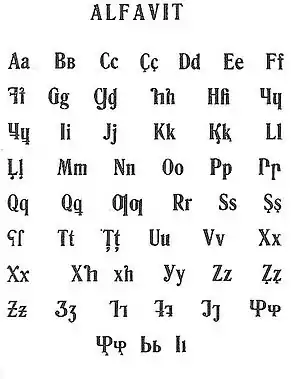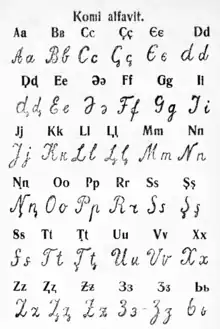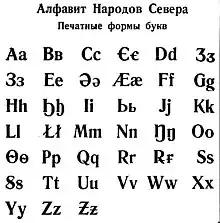| Small capital B | |
|---|---|
| B ʙ | |
.svg.png.webp) | |
| Usage | |
| Writing system | Latin script |
| Type | Alphabetic |
| Language of origin | International Phonetic Alphabet, Uralic Phonetic Alphabet |
| Phonetic usage | /b/, /ʙ/ |
| Unicode codepoint | U+0042, U+0299 |
| History | |
| Development |
|
| Other | |
B, ʙ (small capital B) is an extended Latin letter used as the lowercase B in a number of alphabets during romanization. It is also used in the International Phonetic Alphabet to denote a voiced bilabial trill. In the Uralic Phonetic Alphabet, it denotes a semi-voiced bilabial stop consonant.
It was also used in the writing of medieval Icelandic to denote geminated B.
Use
To avoid the appearance of homoglyphs with a letter, during Soviet latinisation, the alphabets of the Sami, Abaza, Komi, Tsakhur, Azerbaijani, Kurdish and Bashkir languages, as well as the New Turkic alphabet, the Unified Northern Alphabet and the project of reform of the Udmurt script used ʙ as the lowercase form of the letter B. The letter also was used in the Adyghe and Hebrew-Tajik alphabets, although they were absent.
In the Middle Ages, the author of the First Icelandic Grammatical Treatise used 'ʙ' to transcribe geminate B.[1]
In the International Phonetic Alphabet, / ʙ / represents a voiced bilabial trill. The symbol was adopted following the 1989 Kiel Convention.[2]
In the Uralic Phonetic Alphabet, ‹ʙ› represents a semi-voiced bilabial stop consonant, denoted [b̥᪽] or [b̥] with the International Phonetic Alphabet, as opposed to ‹b› representing a voiced bilabial stop consonant.
 The Sami alphabet in 1933
The Sami alphabet in 1933 Abaza alphabet of the 1930s
Abaza alphabet of the 1930s Komi Alphabet in 1934
Komi Alphabet in 1934.JPG.webp)

.svg.png.webp)
Unicode
The letter has been present since the very first version of the Unicode standard and is located in the IPA Extensions block as code point U+0299 ʙ LATIN LETTER SMALL CAPITAL B.[3][4]
Computing codes
| Preview | B | ʙ | ||
|---|---|---|---|---|
| Unicode name | LATIN CAPITAL LETTER B | LATIN LETTER SMALL CAPITAL B | ||
| Encodings | decimal | hex | dec | hex |
| Unicode | 66 | U+0042 | 665 | U+0299 |
| UTF-8 | 66 | 42 | 202 153 | CA 99 |
| Numeric character reference | B | B | ʙ | ʙ |
See also
- B (the Latin letter)
- Ve (Cyrillic), В
- List of Latin letters
- Small capital letters
References
- ↑ "Proposal to add medievalist characters to the UCS" (PDF). 2006-01-30. Retrieved 2019-05-15.
- ↑ International Phonetic Association (1989). "The International Phonetic Alphabet (revised to 1989)". Journal of the International Phonetic Association. 19 (2). Centerfold. doi:10.1017/S002510030000387X. S2CID 249414249.
- ↑ "Unicode Data 1.0.0". Retrieved 2020-11-06.
- ↑ "Uralic Phonetic Alphabet characters for the UCS" (PDF). 2002-03-20. Retrieved 2019-05-15.